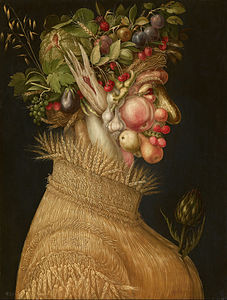FOR EVERYBODY:
- think of a FINAL OUTCOME
- find texts (fictional, non fictional, audio, multimedia, etc) and YOUR COURSEBOOK
- choose the LANGUAGE you can teach :::::go to the new CD to find: Contenidos, Exponentes Lingüísticos, Índices de Avance, etc.
- ORGANIZE your material
- design TASKS
For those teachers who are working with topics such as Healthy Food, Our Food, etc: 4th, 5th & 6th years
- LANGUAGE/ LITERATURE:
- MATHS:
- percentages, numbers, pie/bar charts, colours, countable & uncountable nouns,
- carry out surveys (with frequency of food eaten, type of food, etc) and turn the results into charts,
- ART:
- there are many portraits painted by G Archimbold that can be used as models for "new" paintings in a "school art gallery",
- ss prepare a STALL for MUESTRA DISTRITAL and decorate it, prepare brochures, etc.,
- ss design menus (for roleplay/mini plays),
- GAMES:
- they can "discover" the diff fruit(s) and vegetables in Archimbold's paintings,
- ss play "Simon Says" with CHUNKS (not ONLY "apple",i.e. isolated lexical items; but "red apple, juicy orange, delicious locro", etc. You can mix: ingredients of different meals, traditional food vs fast food, ingredients vs verbs for instructions, etc,
- ss design/play with board games: memory games, dominoes, etc,
- ICT:
- ss can take photographs of food, ingredients, necessary for a recipe,
- ss create a "virtual recipe book" (Power Point presentations: with netbooks in 'pancheras'),
- record steps, instructions, poems, raps, riddles, etc,
- SCIENCE
- ss make "germinación" and record the process (in their copybooks, with photos, write and record (with cell phone) steps,
- ss organize different ingredients or typical food according to vitamins, proteins, carbohidrates, etc,
- SOCIAL STUDIES:
- ss can do a "mini research", like a questionnaire asking members of their families which typical food they prefer/know, their favourite food during their childhood, food from different provinces or nationalities, etc,
- ss create an interactive map (poster) with the food production in Argentina, geographical areas where specific/typical food is made, etc,
- MUSIC
- I came across this video with song. It's here JUST as a SAMPLE, it's for young learners. Perhaps you may find something more approppriate or ADAPT this one!
REMEMBER: the above are NOT tasks. A TASK
- is always divided into 3 parts,
- is always communicative,
- doesn't have ONE answer,
- differs from EXCERCISES in many ways,
- is NOT mechanic,
- can be focused on language or not,
- is always contextualized,
- deals with cognitive activity,
- ...
I could go on and on! But here you have more than enough. I hope you find my SUGGESTIONS interesting and useful.
stella
